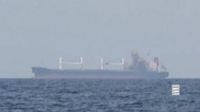In the early hours of September 29, 2025, the calm of the Gulf of Aden was shattered when the Dutch-flagged cargo ship Minervagracht came under a fierce missile attack, igniting a fire that left the vessel adrift and its multinational crew scrambling for safety. The assault, confirmed by multiple naval and maritime authorities, marks a stark escalation in the ongoing threats to commercial shipping in one of the world’s most vital maritime corridors.
According to the EU Naval Force Operation ASPIDES, the attack occurred roughly 128 nautical miles southeast of Yemen’s port city of Aden. The vessel, operated by Amsterdam-based Spliethoff, was traversing international waters when it was struck by what maritime security expert Martin Kelly described as “at least one Anti-Ship Ballistic Missile (ASBM),” resulting in a “serious fire reported on board.” Spliethoff’s own statement described the strike as “an attack of an unidentified explosive device, inflicting substantial damage to the ship.”
The aftermath was immediate and chaotic. The ship’s master sent out an urgent distress call, prompting Operation ASPIDES to launch a rapid rescue effort. All 19 crew members—hailing from Russia, Ukraine, the Philippines, and Sri Lanka—were evacuated by helicopter, though two suffered injuries. One crew member was reported in stable condition, while another, more severely wounded, was airlifted to Djibouti for medical care, as reported by the Associated Press. The vessel, meanwhile, remained ablaze and adrift, presenting a navigational hazard to others in the area.
Notably, the Minervagracht had not requested naval protection prior to the incident—a detail that some maritime analysts say may have left it more vulnerable. Adding another layer to the drama, the vessel was not transmitting its automatic identification system (AIS) signal at the time of the attack, having last been tracked in Djibouti the previous day. As Kelly noted on X, “So seems to have sailed dark.”
This was not the first time the Minervagracht found itself in the crosshairs. Just one week earlier, on September 23, the same vessel was reportedly targeted in the Gulf of Aden, with crew reporting “a splash and the sound of an explosion” some 120 nautical miles east of Aden. While that attempt failed, the latest attack left little doubt about the growing risks facing merchant ships in the region.
Responsibility for the strike has not been officially claimed, but evidence and expert analysis point squarely at Yemen’s Iran-aligned Houthi rebels. The French military’s Maritime Information, Cooperation and Awareness Center identified the Houthis as the likely perpetrators, and the Associated Press reported that a missile launch was observed from Yemen at the time of the attack. The rebels have a well-documented history of launching missile and drone attacks on commercial shipping in the Red Sea and Gulf of Aden, often in response to the ongoing conflict in Gaza. Their campaign, which they say is in solidarity with Palestinians, has targeted over 100 ships and even Israel itself since 2023.
However, the U.S. Navy-overseen Joint Maritime Information Center made clear that the Minervagracht had “no Israeli affiliations.” This is a crucial point, as the Houthis have repeatedly claimed to focus their attacks on vessels connected to Israel or those conducting business with Israeli ports. Yet, as The Associated Press and Supply Chain Brain both observed, many of the Houthis’ targets—including the Minervagracht—have had little or no connection to Israel.
The significance of this attack extends beyond the immediate damage and injuries. According to EUNAVFOR ASPIDES, “these kinds of attacks pose not only a threat against the Freedom of Navigation but also to the seafarers’ lives, and subsequently to the life of all citizens living in that region.” The naval force reiterated its commitment to protecting human life at sea and ensuring freedom on the high seas—a task that grows more daunting as the threat landscape evolves.
Maritime security expert Martin Kelly placed the incident in grim context, noting that this was “the 3rd successful Houthi engagement in 2025 out of 5 attempts, including the sinking of MAGIC SEAS and ETERNITY C in the Red Sea in July.” He further pointed out that this was “the first successful engagement in GOA [Gulf of Aden] since July 2024 when Singapore-flagged containership LOBIVIA was struck with 2 missiles.” The French military confirmed that the last recorded attack on a commercial vessel in the Gulf of Aden before this was in August 2024, underlining the widening reach of Houthi operations.
The broader implications are hard to ignore. The Red Sea and Gulf of Aden are critical arteries for global commerce, with roughly $1 trillion in goods passing through annually before the outbreak of hostilities. The Houthis’ attacks have upended shipping patterns, forced detours, and driven up insurance premiums for vessels transiting the region. In late July 2025, the group vowed to expand its campaign to include any ship doing business at Israeli ports, regardless of nationality—a chilling prospect for international shipping firms.
Their actions have already proven deadly. In July, the Houthis sank two vessels in the Red Sea, killing at least four crew members and capturing 11 others. Just weeks before, two Greek-owned vessels were attacked, with similarly tragic results. The rebels had paused their campaign during a ceasefire, but resumed attacks following renewed escalation in Gaza. As Reuters reported, “Following the attack, Minervagracht is suffering from a fire. As a result, two of the crew of Minervagracht have sustained injuries. Currently the crew of 19 are being evacuated to nearby vessels by helicopter.”
Despite the mounting toll, many questions remain unanswered. Why was the Minervagracht targeted twice in one week? Was its lack of AIS transmission a factor, or simply a coincidence? And as the region braces for further instability—compounded by the United Nations’ recent reimposition of sanctions on Iran and the ever-present threat of escalation in Gaza—what measures can be taken to safeguard the vital shipping lanes upon which so much of the world depends?
One thing is certain: as the flames aboard the Minervagracht are brought under control and its crew receives much-needed medical attention, the incident serves as a stark warning to the global maritime community. The Gulf of Aden and Red Sea remain perilous waters, and the cost of navigating them safely is rising by the day.






